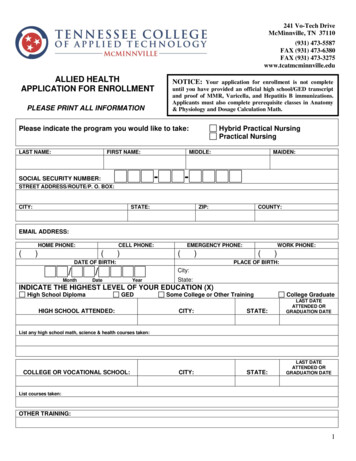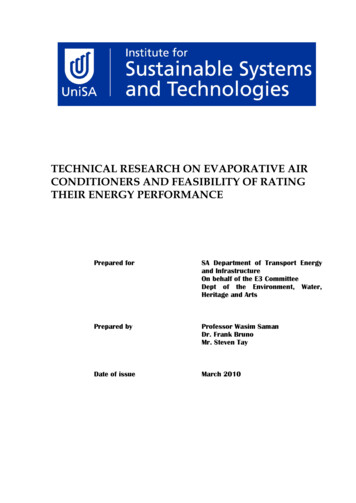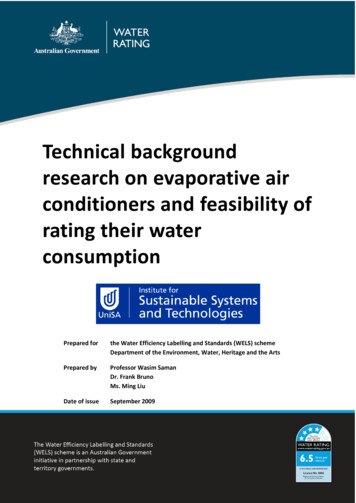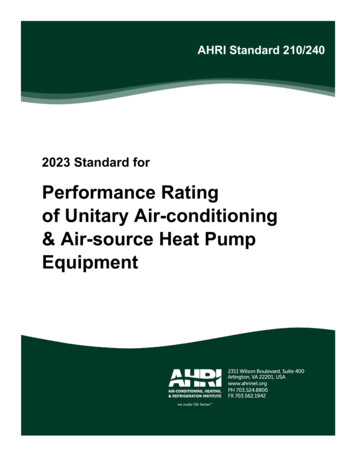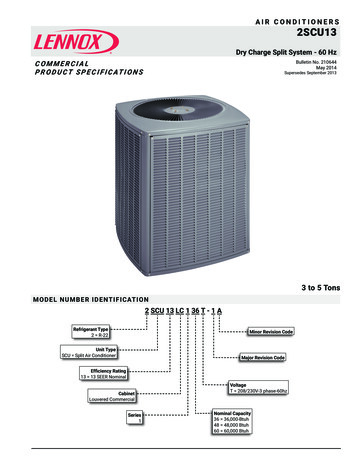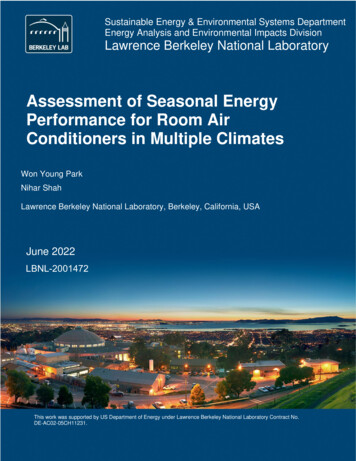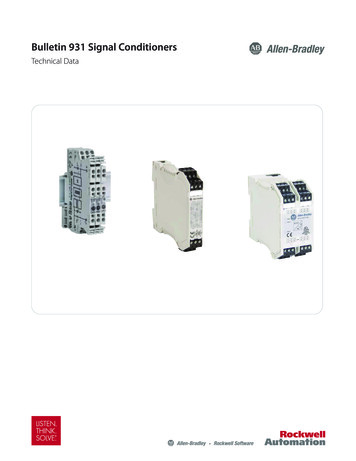
Transcription
Bulletin 931 Signal ConditionersTechnical Data
Bulletin 931Signal ConditionersTable of Contents/Product Line OverviewIntroduction to Signal Conditioners . . . . . . . . . . . . . . . . . . . . . . . . . . . . . . . . . .4Catalog Number Explanation . . . . . . . . . . . . . . . . . . . . . . . . . . . . . . . . . . . . . . .6Product Overview . . . . . . . . . . . . . . . . . . . . . . . . . . . . . . . . . . . . . . . . . . . . . . . .7Product Selection . . . . . . . . . . . . . . . . . . . . . . . . . . . . . . . . . . . . . . . . . . . . . . .11Accessories . . . . . . . . . . . . . . . . . . . . . . . . . . . . . . . . . . . . . . . . . . . . . . . . . . . .37Dimensions . . . . . . . . . . . . . . . . . . . . . . . . . . . . . . . . . . . . . . . . . . . . . . . . . . . .38Glossary . . . . . . . . . . . . . . . . . . . . . . . . . . . . . . . . . . . . . . . . . . . . . . . . . . . . . .41Product Line nsity Signal ConditionersStandard Signal ConditionersUniversal Signal Conditioners Provide solutions for a wide variety of Cost-effective analog signal conditioning inanalog signalsa high-density (6 mm wide) housing Available in compact sizes ranging from12.5 mm to 22.5 mm wide. Programmable— allowing the devices tobe used on a wide variety of analogsignals Two models are available, one housing is12.5 mm wide, the other is 45 mm wideProduct Selection by Function TypeCurrent/VoltagePage 11Page 14Page 35RTDPage 21Page 23Page 35ThermocouplePage 24Page 26Page 35Line-Monitoring—Page 27—Bridge—Page 32—Frequency—Page 33Page 35Page 34——HARTwww.ab.com/catalogsPublication 931-TD001D-EN-P3
Bulletin 931Signal ConditionersIntroductionAnalog Signal Conditioner FunctionalityAnalog Signal Conditioners are designed for use with Rockwell Automation I/Osystems to provide reduced installation and maintenance costs in processapplications. The products are available with two way isolation (between inputand output) or three way isolation (between input, output and power). Isolation of analog measurement and control signals with 2 way isolation(between input and output) or 3 way isolation (between input, output and power). Conversion of analog signals from voltage to current. (i.e. 0.10V to 4.20 mA,etc.) Amplification, linearization, and transmission of low level sensor signals (i.e., mVsignals from thermocouples, etc.). Transmission of analog signals over long distances Provides local display using a splitter or remote status indications and alarms viarelay contact closures based on the analog signals.Typical ApplicationsAnalog Signal Conditioners are used wherever temperature, pressure, level, flow, weight, speed, etc. is measured and controlled as part of acontinuous or batch production process. Analog Signal Conditioners help to prevent these measurements from being degraded on their wayfrom the field to the control room by providing protection from external influences or problems that result from the installation methods used.Typical industries include power plants, steel production, water and wastewater plants, oil and gas production, and chemical processing.Integrated ArchitectureScalable . . . Multi-disciplined . . . Information EnabledThe Rockwell Automation Integrated Architecture system improves your productivity and reduces total cost of ownership by providingunparalleled functionality, flexibility and scalability. Using sophisticated control, networking, visualization and information technologies, theIntegrated Architecture addresses a full range of control and information needs for discrete, motion, process and batch control, drive control,and safety applications.Analog Signal ProcessingAnalog signals involve the measurement of constantly changing physical operating characteristics which come in many different forms, themost common of which are temperature and pressure. These signals are often found in processes that involve harsh industrial environments orare exposed to the elements. Such environmental conditions can significantly affect the quality of the transmitted signal and are also constantlychanging themselves. Additionally, such industrial processes often require that these signals are able to be accurately transmitted over longdistances.For these and a variety of other reasons, analog signal conditioning is often required between the measuring instrumentation and thecontrol system. Analog signal conditioning is a long established practice in many process industries such as oil and gas processing,pharmaceutical and chemicals industries and standardized electrical signals are normally used. Currents of 0.20 mA or 4.20 mA and voltagesof 0.10 V DC are the most often specified by controls engineers.Visit our website: www.ab.com/catalogs4Publication 931-TD001D-EN-P
Bulletin 931Signal ConditionersIntroductionBulletin 931 Signal Conditioners Product RangeRockwell Automation offers a wide range of products to condition analog signalsaccording to industry standards. The Bulletin 931 Analog Signal Conditioners alsoprovide the necessary isolation of the field measurement device from the controlleras well as from any external power supplies. Such isolation prevents interferencethat can occur due to ground loops or common mode noise. The wide range ofAllen-Bradley Bulletin 931 Analog Signal Conditioners completely covers thefunctions involved in analog signal conversion, isolation, and monitoring. Theproduct range addresses nearly all applications in industrial measuring technologyand safeguards the elementary functions between field signals and control systems.The products are easily mounted on 35 mm DIN rail and come in standardelectronic housings with widths of 6, 12.5, 17.5, 22.5, or 45 mm.StandardAnalog Signal ConditionersProblem solvers for process automation.Given the wide variety of analog I/O available with today’s modern industrial and process controlsystems, some may question why Analog Signal Conditioners are used. Here are a few examples ofwhy an Analog Signal Conditioner might be desirable or required in an installation.High-Density Local Alarm/IndicationMany analog signals are passed to local indicators and alarms, which then need to be isolated fromeach other. Long Distance TransmissionUniversalInstead of running expensive cable to the control system (e.g., thermocouples for temperature), AnalogSignal Conditioners can isolate and convert to a high level signal that is easier to transmit (e.g., 4.20mA). Non-Isolated Analog I/OIf the existing control system does not provide isolated analog inputs, a separate Analog SignalConditioner will often be used to provide signal isolation when required e.g., if the control systemneeds to be protected from electrical noise pulses on its analog inputs. Isolation of the Power SourceWhere the control system cannot provide power for the sesnor / transmitter, it is often convenient toprovide isolation of the power source using an Analog Signal Conditioner. Local Display and LinearizationWhen a dedicated local display is required, the analog signal can be split using an Analog SignalConditioner. For example, where a liquid volume indicator is needed for filling a bulk storage tank, butthe measurement is level (level to volume conversion depends on the shape of the tank). The remaining I/O available in an existing system does not provide for the input type of thesensor required.Example: The remaining I/O in the control system requires a 4.20mA analog inputs and the sensorsprovide less common signals – e.g., 0 20mV, 2.10V, 0.10V , 0.1mA, 4.12 mA, 0.5 A (AC), etc.www.ab.com/catalogsPublication 931-TD001D-EN-P5
Bulletin 931Signal ConditionersIntroductionAnalog Signal ProcessingAnalog signals involve the measurement of constantly changing physical operating characteristics which come in many different forms, themost common of which are temperature and pressure. These signals are often found in processes that involve harsh industrial environmentsor are exposed to the elements. Such environmental conditions can significantly affect the quality of the transmitted signal and are alsoconstantly changing themselves. Additionally, such industrial processes often require that these signals are able to be accurately transmittedover long distances.VcU/IU/IU/IVcVcTwo-Way IsolationTemperature MeasurementThermocouplesAnalog signal conditioners with 2-way isolation separate the inputand output signals from each other electrically and decouple themeasuring circuits. Potential differences caused by long line lengthsand common reference points are eliminated. The electricalseparation also protects against irreparable damage caused by overvoltages as well as inductive and capacitive interference.U/IAnalog signal conditioners for connecting conventionalthermocouples are fitted with cold trap compensation as standard.These devices amplify and linearize the voltage signal provided bythe thermocouple. This guarantees accurate analog signalconditioning while eliminating sources of interference or error.fU/IU/IVcVcThree-Way IsolationFrequency ConversionAnalog signal conditioners with three-way isolation separate thesupply voltage from the input and output circuits as well andenables the analog circuit to operate with just one operatingvoltage.Analog signal conditioners are available to convert frequencies intostandard analog signals. Downstream controls can therefore directlyprocess pulse strings for measuring rpm or speed.I AC/DCIU/ISchaltIVcCurrent MonitoringPassive IsolationAnalog signal conditioners with passive isolation offer an additionaladvantage in that they do not require an additional voltage supply.The power supply to the analog signal conditioner can be providedeither by the input or output circuit. This current loop feed ischaracterized by very low power consumption.Analog signal conditioners are available for current monitoring forcurrents up to 60A AC or DC. These devices cause a switchedoutput to be triggered by currents above or below the set value andmay also provide analog outputs for continuous monitoring of theload current.U AC/DCPT100U/IU/IVcVcVoltage MonitoringTemperature MeasurementPT100A number of analog signal conditioners are available for temperaturemeasurements. For example, PT100 signals in 2-, 3- and 4-wiresystems are converted into standard 0.20 mA, 4.20 mA and0.10V signals.Analog signal conditioners are available for voltage monitoring ofboth AC and DC voltages. Voltage fluctuations due to switchingprocesses or overload conditions can be detected for voltagesabove or below the user-defined switching threshold.Visit our website: www.ab.com/catalogs6Publication 931-TD001D-EN-P
Bulletin 931Signal ConditionersCatalog Number ExplanationCatalog Number ExplanationNote: Examples given in this section are for reference purposes. This basic explanation should not be used for product selection; some combinations may not produce a valid catalog number.931Sa– dardUUniversalA10(4) 20 mAbA24 20 mACodeA5A1C10(4) 20 mAA24 20 mAA30 1 A, 0 5 A or 0 10 A ACA40 20 A, 0 25 A or 0 30 A AC/DCC2C3BridgeB1-500 mV 500 mVC5C2C3C4C9DescriptionIPInput Loop PowerOPOutput Loop PowerBCAux AC or DC PowerDCDC Aux PowerMCfrom the Measuring Circuit0 5V or 0 1 VDC0 20 mA or 4 20 mAf0 10V DCMiscellaneous0 20 mA or 4.20mACodeDescription0 10V DC1One Channel0 22mA2Two Channels0. 10VHallHall Effect SensorHart Communication ProtocolHartCableCable1ROne Relay0 20 mA or 4 20 mA0 20 mA, 20 0 mA or 4 20 mA, 20 4mA2RTwo Relays0 10V DC0 10V0 5V or 0 1V DC0 20 mA or 4.20mA0 10V DCC6C7R10 22 mAConfiguration Setting 0.1 mA 100 mAUniversal Inputs2-,3-wire PNP/NPN, namar initiator,push/pull step0. 20 mA3 A relay contact closure digital outputd 20mV. 200VPotentiometerP1Code0 20 mAFrequencyF1Power Type0 5V, 5 0V DC or 10 0V, 0 10V DCVoltage or CurrentC1(2) 4 20 mAVoltage or CurrentDescriptionCurrentDescriptionCurrentInput TypeCodeeOutput TypeCodeDescriptionNNon-configurableDDIP SwitchJJumperCComputerPT 100/2/3/4-Conductor or Ni 100/2/3/4ConductorP2PT 100/2/3-ConductorP3PT 100/2/3/4-ConductorThermocoupleT1Type JT2Type KT9Types K,J,T,E,N,R,S,BV124 70V, 70 140V, 140 210V or210 260V AC/DCVoltageVisit our website: www.ab.com/catalogsPublication 931-TD001D-EN-P7
Bulletin 931Signal ConditionersProduct OverviewBulletin 931H - High-Density SeriesThe modules in the High-Density series provide cost-effective analogsignal conditioning in a very small package. Extreme high-density mounting (6 mm wide modules) Provide isolation and conversion solutions for a variety of signals Current Voltage Temperature (thermocouples and RTDs) The DIP switches can be accessed from outside the housing Capability to jumper incoming power from unit to unit using standardBulletin 1492 terminal block jumpers on most Bulletin 931H devices Wiring diagrams printed on outside of housing for ease of use incommissioning and maintenance activities End barrier is required for Cat Nos: 931H-P2A2N-OP and 931HA1A1N-IP.Cat. No. 931H-P2A2N-OPPower ConnectionsStandard Bulletin 1492 jumpers can be used to connect units to thesame Bulletin 1606 power supply. These jumpers provide a fast and easy wayto provide power to a series of Bulletin 931 analog signal conditioners mountedtogether on a DIN Rail.Cat. No. 931H-A1A1N-1PDIP Switch ProgrammableThe Bulletin 931H products are easily programmable with theDIP switches located on the outside of the housing along withthe printed tables of the possible input and output combinations.High-Density HousingThe Bulletin 931H product line offers a wide range of functionality in thehigh-density 6mm housing.End Barrier, Cat. No. 931H-EB1Wiring DiagramsBulletin 931H products have the wiring diagrams printed on the outside of thehousing to reduce complexity during installation and maintenance.www.ab.com/catalogs8Publication 931-TD001D-EN-P
Bulletin 931Signal ConditionersProduct OverviewBulletin 931S - Standard SeriesThe Bulletin 931S Standard Series of analog signal conditioners provide solutions for a wide variety of analog signals. They are available incompact sizes ranging from 12.5. 22.5 mm in width. Provide isolation and conversion solutions for a wide variety of signals: Current Voltage Temperature (thermocouples and RTDs) Frequency Load Cells (bridge transducers) Potentiometers Removable, plug-in terminal blocks are coded to eliminate wiring errors. The printed circuit board can be removed and re-installed without tools providing ease-of-use when accessing the internal DIP switches. Capability to jumper incoming power from unit to unit using standard Bulletin 1492 terminal block jumpers on some 931S devices. Jumper settings printed on outside of housing for ease-of-use in commissioning and maintenance activities.Circuit Board RemovalThe printed circuit board can be removed without any tools. Once theterminal blocks are removed, simply press in the locking hook at the topand pull out the printed circuit board. This makes accessing the internalDIP switches fast and easy.Power ConnectionStandard Bulletin 1492 jumpers can be used to connect units to thesame Bulletin 1606 power supply. These jumpers provide a fast andeasy way to provide power to a series of Bulletin 931 analog signalconditioners mounted together on a DIN Rail.Safe Isolation“Protective separation” has to be guaranteed as per EN 50178. TheBulletin 931S series omplies with full separation between the analogsignal and the incoming power.Removable Terminal BlocksRemovable terminal blocks are coded for easy removaland replacement without error. They accommodatewire sizes up to 14 AWG (2.5 mm2).Standardized HousingsThe housings come in 3 standard sizes, 12.5, 17.5, and 22.5 mm.Ventilation slots provide for heat dissipation. Jumper and DIP switchsettings are printed on the side of the housing for ease of use incommissioning and maintenance.www.ab.com/catalogsPublication 931-TD001D-EN-P9
Bulletin 931Signal ConditionersProduct OverviewBulletin 931U- Universal SeriesThe Bulletin 931U Universal Series of analog signal conditioners are programmable, allowing the devices to be used on a wide variety ofanalog signals. Two models are available, one in a 12.5mm wide housing and one in a 45mm wide housing. Both are programmable usingsoftware. Provide isolation and conversion solutions for a wide variety ofsignals: Current Voltage Temperature (thermocouples and RTDs) Potentiometers AC and DC current monitoring Removable, plug-in terminal blocks are coded to eliminate wiringerrors. Programmable using software, which is bundled with theprogramming cable - Cat. No. 931U-CABLE.Bulletin 931U Programming SoftwareUniversal InputsThe Bulletin 931U products can input a wide range of analog signals(current, voltage, thermocouple, RTD, resistance, frequency, etc).Software ProgrammableThe Bulletin 931-U products are programmed using the softwareand cable included in 931U-CABLE product. The cable connectsfrom the front of the signal conditioner unit to your computer’s USB port.CertificationsAllen-Bradley’s Bulletin 931U product line has been certified to globalcertifications. These products not only have cULus –Class 1, Div. 2, Groups A, B, C, and D ratings, but also the European CEand ATEX markings.Analog/Digital OutputsThe Bulletin 931U products have the capability to output both analog anddigital signals. Using the programming software you can have the unitoutput a current or voltage signal and also dual digital signals fromtwo CO contacts.www.ab.com/catalogs10Publication 931-TD001D-EN-P
Bulletin 931Signal ConditionersCurrent/Voltage Signal ConditionersPassive Isolator, 1 Channel Passive isolator for electrical isolation of standard 0.20 mA or 4.20 mA signals No need for auxiliary power supply Low power consumption931H-A1A1N-IPSpecificationsPassive Isolator, 1-Channel4-Wiring Diagram5Standards ComplianceCertifications OUTZ18V2-CCINZ18V 1UL 508, CSA C22.2 No. 142-M1987, CSA C22.2 No. 0-10,CSA C22.2 No. 14-10, EN 50178:1997, EN 61000-6-1:2007,EN 61000-6-2: 2005, EN 61000-6-3:2007, EN 61000-6-4:2007cURus (NRAQ2/8.E113724), CSA, CEInput RatingsCurrent0(4).20 mAMax Voltage15VMax Current50 mAPick-up Current 100 μAVoltage Drop2.5 .3 V at 20 mAInputPassiveOutput RatingsCurrent0(4).20 mAVoltage—Load Impedance(voltage/current)— / 500 ΩStep Response Timeapprox. 1.2 msAccuracy 0.1% of final valueTemperature Coefficient 50 ppm/K of measurement value at 0 Ω load resistanceResidual Ripple 10 mVCut-off Frequencyapprox. 200 kHzOutputActiveGeneral SpecificationsPower TypeInput Loop PoweredOperating Temperature-25 C 60 CStorage Temperature-40 C 85 CIsolation Voltage Input Output500VeffRated Isolation Voltage50VConnection TypeTension clampL x W x H (mm)Signal ConditionerEnd Barrier (required)91 x 6 x 63.2Cat. No.Pkg. sPublication 931-TD001D-EN-P11
Bulletin 931Signal ConditionersCurrent/Voltage Signal ConditionersActive Isolator, 3-Way Two conductor system Three port isolation Power supply can be cross-connected using center jumpers931H-A2A2N-DCSpecificationsActive Isolator, 3-Way30V424 V DCcccc52Wiring DiagramPSVOut Standards ComplianceCertificationsCurrentLoop1 II 6 UL 508,CSA C22.2 No. 0-10, CSA C22.2 No. 14-10,EN 50178:1997, EN 61000-6-1:2007, EN 61000-6-2: 2005,EN 61000-6-3:2007, EN 61000-6-4:2007cURus (NMTR2/8.E56639), CEInput RatingsCurrent4.20mASensor2-conductorSupply Voltage16.5V / constant for 3 22 mAInputActiveOutput RatingsCurrent4.20 mALoad Impedance(voltage/current) 10 kΩ/ 500 ΩAccuracy 0.1 %Temperature Coefficient 50 ppm/KStep Response Time 2msOffset Current 30 μAResidual Ripple 10mVOutputActiveGeneral SpecificationsSupply Voltage24V DC 15%Power Consumptionapprox. 1 WCurrent Carrying Capacity ofCross Connect 2AOperating Temperature0 C 55 CStorage Temperature-25 C 85 CRated Insulation Voltage300VIsolation Voltage Input Output1.5kVeffSurge CategoryIIPollution Severity2Connection TypeScrewL x W x H (mm)88 x 6.1 x 97.8Signal ConditionerCat. No.Pkg. tion 931-TD001D-EN-P
Bulletin 931Signal ConditionersCurrent/Voltage Signal ConditionersActive Converter, 3-Way Three way isolation Calibrated change over via DIP switch Power supply can be cross-connectedusing plug-in jumpers Low power lossSpecifications931H-C2C2D-DCActive Converter, 3 WaySetting options/switch positionSwitchS1InputWiring DiagramStandards ComplianceCertificationsUL 508,CSA C22.2 No. 0-10, CSA C22.2 No. 14-10,EN 50178:1997, EN 61000-6-1:2007, EN 61000-6-2: 2005,EN 61000-6-3:2007, EN 61000-6-4:2007Voltage0.10VMax. Voltage30V121234560 20 mA0 20 mA 0 20 mA0 20 mA4 20 mA0 10 V 4 20 mA0 20 mA 4 20 mA4 20 mA0 10 V4 20 mA0 10 V0 20 mA 0 10 V4 20 mA 0 10 V0 10 V cURus (NMTR2/8.E56639), CEInput Ratings on offConnectionPSCurrent0.20 mA / 4.20 mAMax. Current 100 mAInput Resistance(voltage/current)100 kΩ / 5 ΩVoltage Drop 0.1V at IIN 20 mA (current input)InputPassive-VVoltage0.10VCurrent0.20 mA / 4.20 mALoad Impedance(voltage/current) 10 kΩ / 500 ΩmAIN Step Response Time10 msAccuracy 0.5% of final valueTemperature Coefficient 150 ppm/K of final valueCut-off Frequency (-3 dB) 100 Hz 34PS2-Output RatingsOutputS2OutputV/I5-V/I16OU TmAV ActiveGeneral SpecificationsSupply Voltage24V DC 15%Power Consumptionapprox. 0.6 WCurrent Carrying Capacity ofCross Connect 2AOperating Temperature0 C 55 CStorage Temperature-25 C 85 CDefault Settings0 20 mA / 0 20 mARated Insulation Voltage50VIsolation Voltage Input Output500Veff / 1 sSurge CategoryIIPollution Severity2L x W x H (mm)Signal Conditioner88 x 6.1 x 97.8Cat. No.Pkg. on 931-TD001D-EN-P13
Bulletin 931Signal ConditionersCurrent/Voltage Signal ConditionersActive Converter, 3-Way Signal conversion Electrical isolation between input/output signal and power supply Power supply can be cross-connected using center jumpers931S-A1A1N-DCSpecificationsActive Isolator, 3-WayWiring DiagramStandards ComplianceCertificationsUL 508, CSA C22.2 No. 142-M1987, EN 50178:1997,EN 61000-6-1:2007, EN 61000-6-2: 2005, EN 61000-6-4:2007cULus (NRAQ/7.E113724), CEInput RatingsCurrent0(4).20 mAMax Current25 mAInputPassiveOutput RatingsCurrent0(4).20 mALoad Impedance(voltage/current)— / 600 ΩStep Response Time 45 msAccuracy0.2%Temperature Coefficient 250 ppm/K of final valueCut-off Frequency (-3 dB)10 HzOutputActiveGeneral SpecificationsSupply Voltage24V DC 25%Power Consumption 1.5 W at IOUT 20 mACurrent-Carrying Capacity ofCross-Connect 2AOperating Temperature0 C 55 CStorage Temperature-20 C 85 CRated Insulation Voltage300VImpulse Withstand Voltage4kVIsolation Voltage Input/Output2kVeff /5 sSurge CategoryIIIPollution Severity2Connection TypeScrewL x W x D (mm)Signal Conditioner92.4 x 17.5 x 112.4Cat. No.Pkg. tion 931-TD001D-EN-P
Bulletin 931Signal ConditionersCurrent/Voltage Signal ConditionersPassive IsolatorU E [V] Reliable isolation Very low power -IP1931S-A1A1N-IP2Passive Isolator, 1-channelPassive Isolator, 2-channel600SpecificationsWiring DiagramStandards ComplianceCertificationsUL 508, UL 1604, CSA C22.2 No. 142-M1987, CSA C22.2 No. UL 508, UL 1604, CSA C22.2 No. 142-M1987, CSA C22.2 No.213-1987, EN 50178:1997, EN 61000-6-1:2007, EN 61000-6- 213-1987, EN 50178:1997, EN 61000-6-1:2007, EN 61000-6-2:2: 2005, EN 61000-6-3:2007, EN 61000-6-4:20072005, EN 61000-6-3:2007, EN 61000-6-4:2007cULus (Class 1, Div. 2, Groups A, B, C and D,NRAG/7.E10314), CSA, CEcULus (Class 1, Div. 2, Groups A, B, C and D,NRAG/7.E10314), CEInput RatingsVoltage——Current0(4).20 mA0(4).20 mAPick-up Current 100 μA 100 μAVoltage Dropapprox. 3V at RL 0 Ω, approx. 13V at RL 500 Ω (IIN 20mA)approx. 3V at RL 0 Ω, approx. 13V at RL 500 Ω (IIN 20mA)Max Voltage18V18VMax Current50 mA50 mAInputPassivePassiveOutput RatingsVoltage——Current0(4).20 mA0(4).20 mALoad Impedance(voltage/current)— / 500 Ω— / 500 ΩTemperature Coefficient 50 ppm/K of final value 50 ppm/K of final valueResidual Ripple 20 mV 20 mVStep Response Time4.5 ms4.5 msAccuracy 0.1% of final value 0.1% of final valueOutputActiveActiveGeneral SpecificationsPower TypeInput Loop PoweredInput Loop PoweredOperating Temperature-25 C 70 C-25 C 70 CStorage Temperature-40 C 80 C-40 C 80 CRated Insulation Voltage300V300VImpulse Withstand Voltage6kV6kVIsolation Voltage Input Output4kV/1 s4kV/1 sIIISurge CategoryIIIPollution Severity22Connection TypeScrewScrewL x W x D (mm)Signal Conditioner92.4 x 17.5 x 112.492.4 x 17.5 x 112.4Cat. No.Pkg. QuantityCat. No.Pkg. atalogsPublication 931-TD001D-EN-P15
Bulletin 931Signal ConditionersCurrent/Voltage Signal ConditionersActive Isolator Signal conversion Electrical isolation between input and output signals Power supply can be cross-connected using center jumpers931S-A2A2N-DCSpecificationsActive IsolatorWiring DiagramStandards ComplianceUL 508, UL 1604, CSA C22.2 No. 142-M1987, CSA C22.2 No.213-1987, EN 50178:1997, EN 61000-6-1:2007, EN 61000-6-2:2005, EN 61000-6-3:2007, EN 61000-6-4:2007CertificationscULus (Class 1, Div. 2, Groups A, B, C and D,NRAG/7.E10314), CEInput RatingsCurrent4.20 mAMax Current25 mAMax Voltage7VInputPassiveOutput RatingsCurrent4.20 mALoad Impedance(voltage/current)— \ 500 ΩAccuracy 0.2% of final valueTemperature Coefficient 250 ppm/KStep Response Time 30 msCut-off Frequency (-3 dB) 15 HzOutputActiveGeneral SpecificationsSupply Voltage24V DC 20%Current Consumption 32 mA at I 20 mACurrent Carrying Capacity ofCross-Connect 2AOperating Temperature0 C 55 CStorage Temperature-20 C 85 CRated Insulation Voltage300VImpulse Withstand Voltage4kVIsolation Voltage Input Output1.2kVeff/1 sSurge CategoryIIIPollution Severity2Connection TypeScrewL x W x D (mm)Signal Conditioner92.4 x 12.5 x 112.4Cat. No.Pkg. tion 931-TD001D-EN-P
Bulletin 931Signal ConditionersCurrent/Voltage Signal ConditionersPassive Isolator, Splitter Electrical isolation Input and output current loop feed Very low power consumption No callibration necessary931S-A2A5N-OP24V DCSpecificationsSensorPassive Isolator, Splitter230 V AC 24 V DC4 . 20 mAWiring Diagram123Standards ComplianceCertifications789UL 508, UL 1604, UL 60079-15, CSA E60079-15:02, CSAC22.2 No. 213-1987, CSA C22.2 No. 142-M1987, EN50178:1997, EN 60079-0:2006, EN 60079-15:2005, EN 610006-1:2007, EN 61000-6-2: 2005, EN 61000-6-3:2007, EN 610006-4:2007cULus (Class 1, Div. 2/Zone 2, Groups A, B, C and D,NRAG/7.E10314 and NWGD/7.E10314 ), CE, ATEX (Class 1,Zone 2, Demko 09ATEX 0929065X)4 . 20 mA1011124 . 20 mARL2SPSRL1Input RatingsCurrent4.20 mAMax Current40 mAVoltage Drop3.8VInputPassiveOutput RatingsCurrent2 x 4.20 mAapprox. 31 mAOutput Signal LimitLoad Impedance(voltage/current)— / RL (UB-12 V) / 20 mA e.g. 600 Ω at 24 VAccuracyTypical 0.1%, max. 0.2%Temperature Coefficient 150 ppm/KStep Response Time 20 msCut-off Frequency (-3 dB)30 HzOutputPassiveGeneral SpecificationsSupply Voltagemin. 12V DC, max. 30V DCPower TypeOutput Loop PoweredOperating Temperature0 C 55 CStorage Temperature-20 C 85 CRated Insulation Voltage300VImpulse Withstand Voltage4kVIsolation Voltage Input Output4kVeff/5sSurge CategoryIIIPollution Severity2Connection TypeScrewL x W x D (mm)Signal Conditioner92.4 x 17.5 x 112.4Cat. No.Pkg. on 931-TD001D-EN-P17
Bulletin 931Signal ConditionersCurrent/Voltage Signal ConditionersPassive Converter Electrical isolation Very low power consumption Input range selected via DIP switch No callibration necessary931S-C1A2D-OPSetting options/switch positionSpecificationsInput0 20 mA4 20 mA0 5 V0 10 VTransmission frequency10 Hz100 HzPassive Converter Wiring DiagramCertifications2SW 134 on offExample of application Standards Compliance1230V AC24V DC24V DC 230V ACUL 508, CSA C22.2 No. 142-M1987, EN 50178:1997, EN61000-6-1:2007, EN 61000-6-2: 2005, EN 61000-6-3:2007, EN61000-6-4:2007cULus (NRAQ/7.E113724), CEInput RatingsVoltage0.5V / 0.10V123Current0.20 mA / 4.20 mAMax Voltage30V DCMax Current40 mAInput Resistance(voltage/current)0 5V: 210 kΩ; 0 10V: 430 kΩ / 51 ΩInput7894 . 20 mA0.10VPassiveOutput RatingsSPSCurrent4.20 mAOutput Signal Limitapprox. 24 mALoad Impedance (current)RL (UB-12 V) / 20 mA e.g. 600 Ω at 24 VAccuracy0.2% of measuring range final valueTemperature Coefficient 150 ppm/KResidual Ripple50 mV at 500 ΩStep Response Time 10 Hz: 80 ms; 100 Hz: 50 msCut-off Frequency (-3 dB) 10 Hz/ 100 Hz switchableOutputPassiveGeneral SpecificationsSupply Voltagemin. 12V DC, max. 30V DCPower TypeOutput Loop PoweredOperating Temperature0 C 55 CStorage Temperature-20 C 85 CDefault Settings0.20 mA, 10HzRated Insulation Voltage300VImpulse Withstand Voltage4 kVIsolation Voltage Input Output4 kVeff / 5 sSurge CategoryIIIPollution Severity2Connection TypeScrewL x W x D (mm)Signal Conditioner92.4 x 17.4 x 112.4Cat. No.Pkg. tion 931-TD001D-EN-PRL
Bulletin 931Signal ConditionersCurrent/Voltage Signal ConditionersActive Converter, 3-Way Auxiliary power supply, 12.60V DC Current or voltage input configurable with DIP switch Input or output scaling931S-C3C3J-DCWiring possibility A (input passive) 24 V1234SpecificationsActive Converter, 3-WayStandards ComplianceUL 61010B-1, CSA C22.2 No. 61010-1-2004, EN 50178:1997,EN 61000-6-1:2007, EN 61000-6-2: 2005, EN 61000-6-4:2007CertificationscULus (PICQ/7.E345550), CE0V0VV/IInput Signal Limi
Transmission of analog signals over long distances Provides local display using a splitter or remote status indications and alarms via relay contact closures based on the analog signals. Typical Applications Analog Signal Conditioners are used wherever temperature, pressure, level, flow, weight, speed, etc. is measured and controlled as part of a


